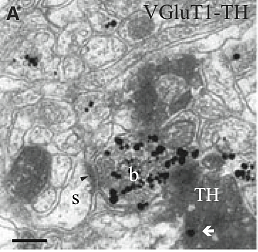Published by Jonathan Moss, Mark Ungless and Paul Bolam in the European Journal of Neuroscience.
Abstract: Midbrain dopamine neurons signal rapid information about rewards and reward-related events. It has been suggested that this fastsignal may, in fact, be conveyed by co-released glutamate. Evidence that dopamine neurons co-release glutamate comes largelyfrom studies involving cultured neurons or tissue from young animals. Recently, however, it has been shown that this dualglutamatergic dopaminergic phenotype declines with age, and can be induced by injury, suggesting that it is not a key feature of adultdopamine neurons. Here, we provide further support for this view by showing that dopaminergic axons and terminals in subregions ofthe adult striatum do not express vesicular glutamate transporters (VGluT1, VGluT2 or VGluT3). Striatal tissue from the adult rat wasimmunolabelled to reveal tyrosine hydroxylase (TH; biosynthetic enzyme of dopamine) and one of the three known VGluTs.Importantly, we compared the immunogold labelling for each of the VGluTs associated with TH-positive structures with backgroundlabelling at the electron microscopic level. In addition, we carried out a subregional analysis of the core and shell of the nucleusaccumbens. We found that dopaminergic axons and terminals in the dorsolateral striatum and ventral striatum (nucleus accumbenscore and shell) do not express VGluT1, VGluT2 or VGluT3. We conclude, therefore, that in the normal, adult rat striatum,dopaminergic axons do not co-release glutamate.
